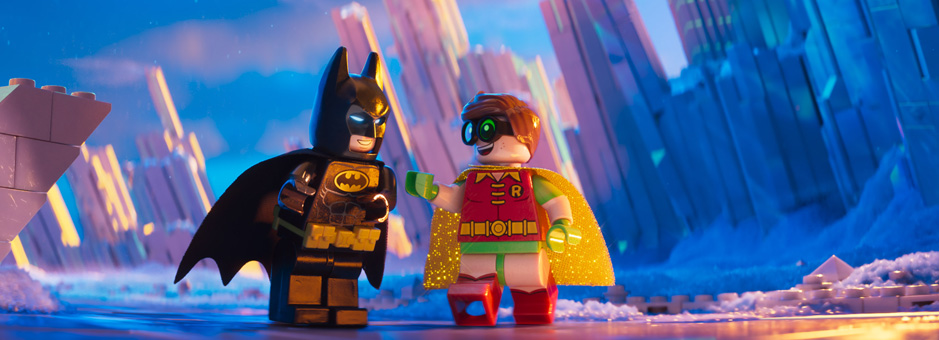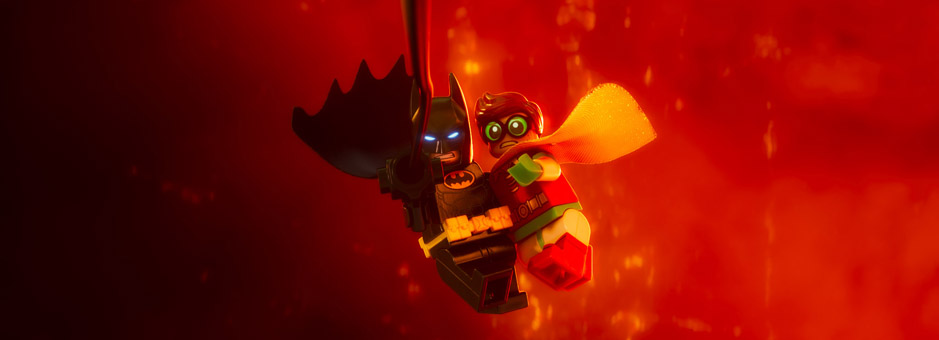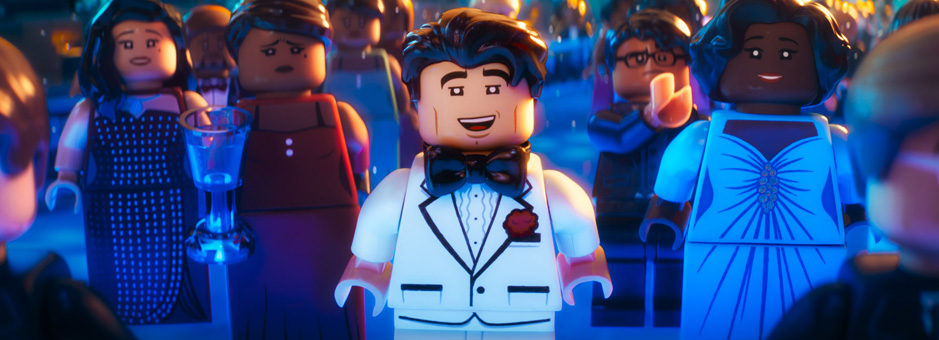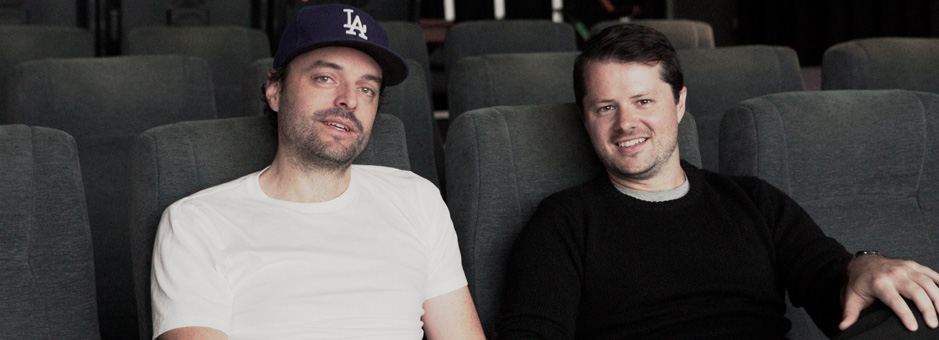Dialing it up to 11 – grading LEGO Batman
Due to a long and productive relationship with Warner Bros. - through films such as Happy Feet, The Matrix and Legend of the Guardians: The Owls of Ga’Hoole – Sydney’s Animal Logic collaborated on The LEGO Movie (released 2014) from pitch and proof of concept through to post.
After the success of this film, Animal Logic and Warner Bros. began working on a spin-off and 3 years later The LEGO Batman Movie is enjoying global success.
Sam Chynoweth and Bram Tulloch talk about grading the latest feature in the LEGO® movie franchise, The LEGO Batman Movie.
Developing the grade
“For this all-animated feature, we acted less as post-production and more as part of the production team,” says Sam Chynoweth, Colourist at Animal Logic. Where we might normally get four weeks to grade a live action movie, here we were embedded in the production process for a year. From near the beginning of the project we were working with production designer Grant Freckelton to develop looks and we essentially became an extension of the lighting, compositing and output departments rather than just waiting for finished shots to be delivered to us.
The process began with Grant and Chris (McKay, the director) where we would work a lot to get exactly the right feel. At one stage we were dark and gritty and very Batman - very early on they had some ideas where they wanted elements of a 70’s film so we had to work out how we could incorporate those but keep it feeling modern - and then we lifted it up a little to get a bit of fun happening.
We ended up coining the phrase “baby’s first apocalypse”: dark and gritty and Gotham-like, but all the bits that could be made fun would be fun, and anything that could be turned up was turned up to 11. Our motto all the way through was “enhance, enhance!”.
Collaborative working with VFX and editorial
“One thing which is commonly misunderstood in animated features is the expectation that shots will come to us already balanced. On LEGO Batman we had about 300 artists working on scenes throughout the movie, and shot-to-shot you can have different compositors putting in their own nuances, so there is still quite a lot of basic balancing needed to bring it into line.
From there we did a lot of secondaries. Working alongside production gave us the opportunity for massive attention to detail. We had a heavily multi-channel EXR set-up delivering us a series of passes from lighting, so we were really able to get in there and manipulate things to the nth degree.
One of the most beneficial aspects of this process is that we were taking pressure off the up-stream departments. We would take on the load so that the artists could be producing more work.
For every frame of the movie we got a single EXR file which had three views: the standard left and right stereo 3D channels and we would often have a mono camera as well to maintain symmetry.
Packed into each EXR file we would have a breakdown of mattes for characters, body parts, camera and world position, and so on. One of the most important layers we used was a surface colour pass, which gives the base, non-reflective colour of the scene. If we found events where maybe things had too much reflection we could multiply that pass back to bring the reflection down. It not only restored natural colour to the characters, but it also helped to control that crazy, saturated look.
So we were basically using Baselight like a very fast compositor to combine all these layers. And although we did not need to use keying a huge amount as we had all the mattes in the EXR files, we used a lot of shape mattes to do subtle re-lighting. It was much quicker for us to accent things than to send it back to production for relighting.
The ‘behind-the-scenes’ side of Baselight
Bram Tulloch, Editorial and DI Engineer at Animal Logic comments: “The power and flexibility of the Baselight grading system and the cloud network architecture enabled us to work this way relatively easily. We have a Baselight TWO as our hero seat in the grading theatre, and also a Baselight ONE to do some supplementary grading as well as handling much of the stereo 3D work.
We needed a massive amount of storage – the EXR images were between 50 and 150 megabytes a frame – but the FLUX Store sorted that out for us. In fact, we worked with the same data on both on the FLUX Store and the Baselight TWO, because that gave us added security and the ability to switch between machines almost instantly if anything went down”.
Baselight’s powerful and unique feature set also helped achieve the desired look for the movie – as Sam explains: “The Truelight Colour Spaces allowed us to work in a much more flexible way than we would ever have been able to do in the past. We could switch in and out of colour spaces non-destructively to get the most out of our images. Sometimes you need a big gamut, but sometimes that big gamut starts hampering things when you are trying to fine tune the grade.
We were working primarily in ACEScc with some custom tweaks, but we would switch in and out of different spaces as we needed them for different tools. That allowed us to stretch the image in such a way that we could get the most out of it: we could push sections while still maintaining key colours, like Batman’s eyes or Robin’s cape. Even when we were pushing our crazy apocalypse colours we had to keep those catch colours in there so people could easily recognise the characters.
A scene I particularly enjoyed to work on is a dog-fight sequence at the climax of the film, and here the whole “more is more” ethos came into play. We scaled the saturation and the dynamic range up to the maximum, but we used a lot of fast tracking for key characters. There were a lot of important things you needed to be following, but at the same time we wanted to present a spectacle you could just sit back and watch. That was by far the most challenging sequence.
Creating the HDR master grade
We took the regular, standard dynamic range digital grade master over to Dolby in LA and found that it slotted in very easily to the HDR world. There was some re-balancing needed for the inherent new contrast in the HDR system, but no real surprises. We’d done some ‘mock HDR’ tests early on - to make sure that we didn’t have any clamped shots or highlights which had been artificially sat down - making the image darker by shifting the black level down - and once we’d set our key mid-tone, essentially skin tone, at a level which we felt looked right in the HDR scene we then let the highlights move around as needed.
Depending on the production, if it was possible I think it would be better to grade the master in HDR wide gamut and then step back down for the deliverables. There are ‘gotchas’ in live action - things like outside details through windows you can now see in HDR which no-one on set thought about – for example, there may be a lighting stand in shot which they didn’t think you’d be able to see. So it’s better to start in HDR where you can see those problems and make creative choices at that point, then when you come back down to a smaller dynamic range it’s still going to work ok. Grading a movie on an HDR monitor is a little bit contentious though as the HDR you see on a monitor is different to HDR you would see in a cinema.
Baselight 5.0’s benefits
Sam comments, “The Compress Gamut tool in the upcoming Baselight Version 5.0 is a life-saver, particularly when we came to create the Rec. 709 pass. We were able to get all those colours from the big-screen version into the 709 deliverable with minimal compromise. The Compress Gamut tool just revolutionises the way you do it. Not only is it quicker, but you are getting a much better representation. Given Baselight’s render speeds, we were able to do all our deliverables directly from Baselight.
Looking to the future, we are very excited by many of the new tools coming in Baselight 5.0, such as the world-space matte feature and GL shaders, which will save us a lot of time and allow us to write specific tools for production. One of our next big projects (Peter Rabbit) is a hybrid film, and the new screen keyer and perspective tracker will also be huge for us. Baselight has allowed us to push the grading process right back to where we have become a key part of production, not just post. As well as sending DNxHDs to our Avids we are looking at comp pipelines using BLGs - once we have matte support in them we’ll have a lot more of a two-way road and will become even more a part of production than we are now, especially with the early look development. I can certainly see that trend developing in the future.
“The Compress Gamut tool in Baselight 5.0 is a life-saver. We were able to get all those colours from the big-screen version into the 709 deliverable with minimal compromise.
Compress Gamut just revolutionises the way you do it.”
Download








